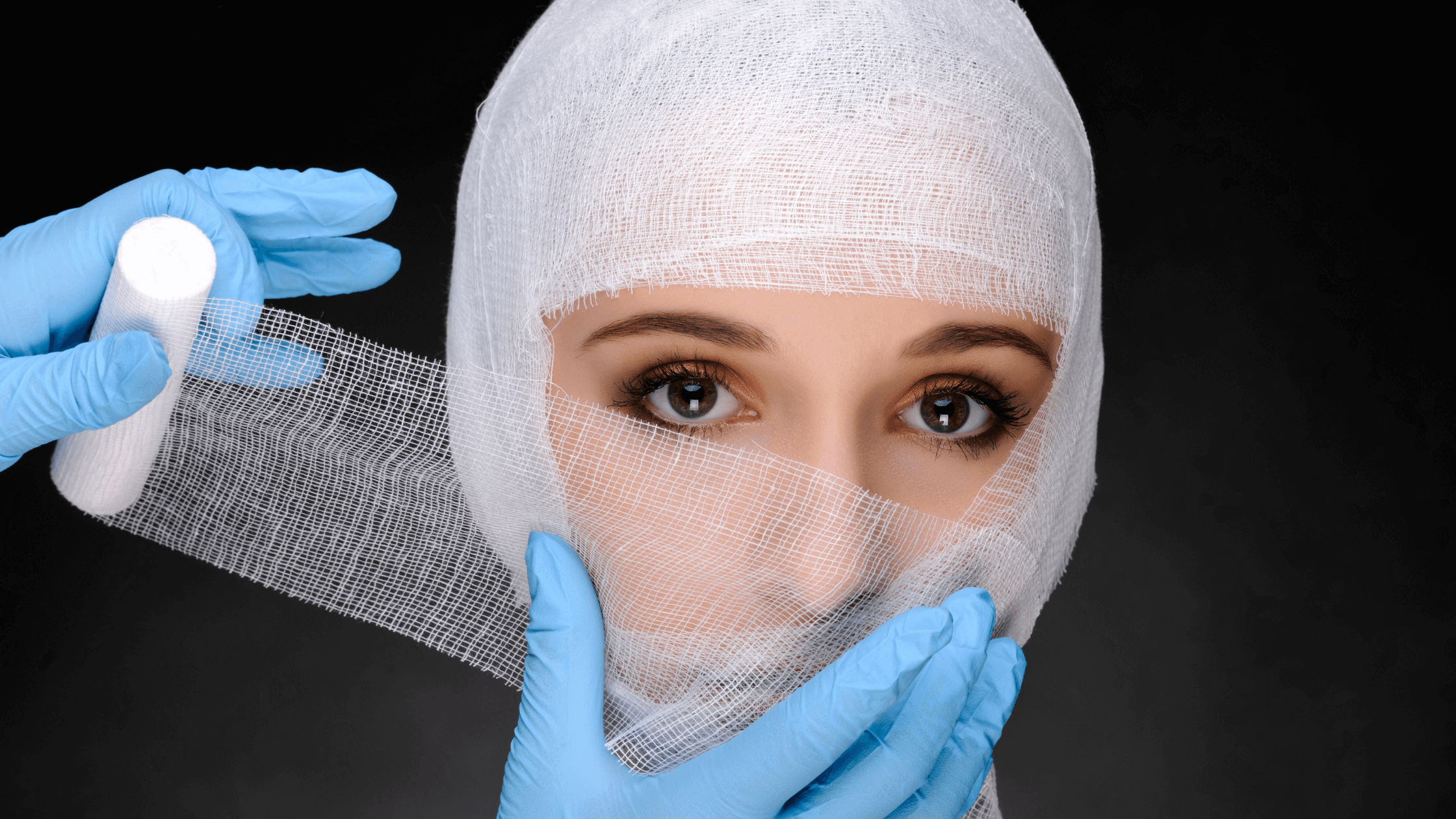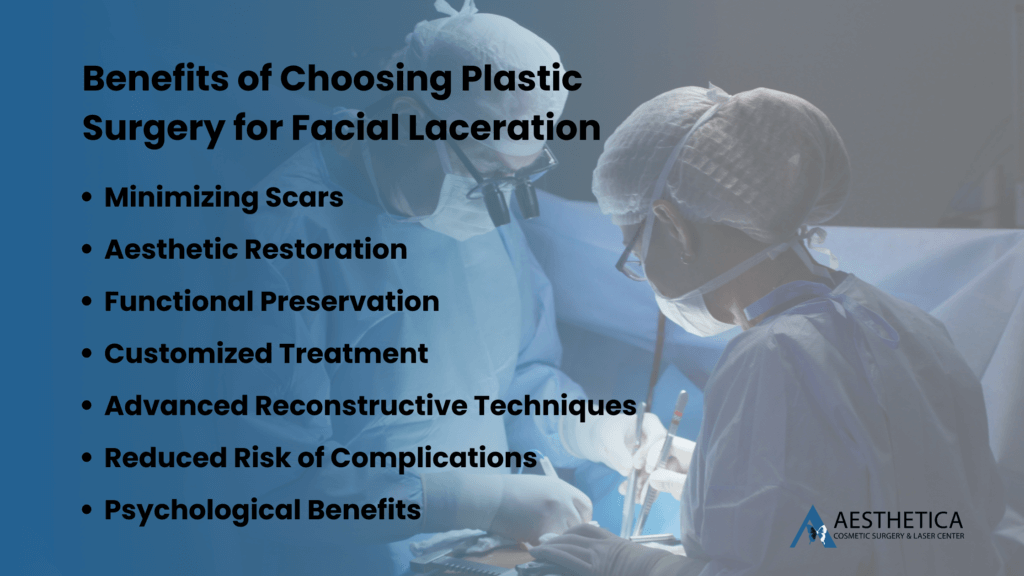Why Facial Lacerations are Best Handled by Plastic Surgeons9 min read

Aesthetica Editorial Team

Facial lacerations are more common than one might think, often resulting from an accidental fall, a sports injury, or an unforeseen event.
While any injury can be distressing, those involving the face can be particularly concerning, touching not just on health but also on identity and self-expression.
At first glance, these injuries might seem like simple cuts, but there’s more to them than meets the eye.
The intricate nature of the face, with its complex anatomy and expressive capability, makes treating these lacerations a task that goes beyond basic medical care.
In the realm of plastic surgeons, professionals like Dr. Chang blend the precision of medicine with the finesse of artistry.
They are the custodians of our facial stories, understanding that every stitch affects not just how we look but how we feel and function—essential in the realm of facial laceration repair.
What Are Classified As Facial Lacerations?

Facial lacerations, also referred to as facial wounds or cuts, encompass a range of injuries to the face that penetrate the skin and, in some cases, the underlying tissues.
They can vary significantly in severity, from superficial nicks to deep incisions affecting muscles, nerves, and even bones.
Understanding the types, effects, and common causes of these lacerations is crucial for appropriate treatment and care.
- Superficial Abrasions or Contusions: Often called scrapes or bruises, these are surface-level injuries that typically affect only the epidermis (the outer layer of skin). They are medically known as “abrasions” or “contusions” and are often caused by friction or blunt trauma. While they generally don’t cause permanent damage, they can be painful and may lead to temporary disfigurement.
- Incised Wounds: These are clean, sharp cuts often caused by sharp objects like glass or a knife. Medically termed as “incisions,” these wounds can vary in depth and severity. Deeper incisions can affect muscles, nerves, and even facial bones, leading to functional impairments and requiring intricate surgical repair.
- Lacerations: These are irregular, jagged wounds caused by blunt trauma. They often occur during accidents, falls, or sports injuries. Unlike incised wounds, lacerations tend to be more traumatic for the surrounding tissues and may involve a combination of cuts, bruises, and tissue avulsions.
- Puncture Wounds: Caused by objects that penetrate the skin, such as nails or animal bites, puncture wounds can be deceptive. They might appear small on the surface but can be quite deep, potentially introducing bacteria deep into the tissue and posing a high risk of infection.
- Avulsions: These are severe wounds where skin or tissue is forcibly detached from the face. Commonly resulting from violent accidents or animal attacks, avulsions can lead to significant blood loss, nerve damage, and long-term disfigurement.
- Complex Facial Trauma: In cases of severe accidents, patients may suffer from complex facial trauma, which involves multiple types of injuries, including fractures, deep lacerations, and soft tissue damage. These cases often require multi-disciplinary treatment involving plastic surgeons, oral and maxillofacial surgeons, and other specialists.
Each of these facial lacerations can have profound effects, not just aesthetically but also functionally.
They can affect critical aspects of facial function, like chewing, speaking, and facial expressions, and can have psychological impacts due to their visible nature.
Understanding the specific nature and severity of these wounds is essential in guiding appropriate medical intervention and achieving the best possible outcomes.
Why Is Specialized Care for Facial Laceration Repair Important?
Specialized care for facial laceration repair is of paramount importance due to the unique complexity and functionality of the face.
Unlike other body parts, the face is not only highly visible, but it also houses a multitude of nerves, muscles, and structures critical for essential functions like speaking, eating, expressing emotions, and sensory perception.
Therefore, a laceration on the face isn’t just a cosmetic concern; it can have profound implications on a person’s physical abilities and psychological well-being.
The intricate nature of facial anatomy requires a surgeon with specialized skills and a deep understanding of the delicate balance between aesthetic appearance and functional preservation.
Plastic surgeons, for instance, are trained to perform meticulous repairs that minimize scarring and preserve the natural contours of the face.
They use advanced techniques tailored to the specific location and depth of the wound, ensuring that the repair is as inconspicuous and effective as possible.
Moreover, specialized care becomes even more crucial in the case of complex lacerations that involve deeper structures like nerves, muscles, or salivary glands.
In such scenarios, the expertise of a plastic surgeon or an oral and maxillofacial surgeon is essential to reconstruct these deeper structures accurately, preventing long-term functional deficits.
Additionally, these professionals are adept at managing the potential complications associated with facial wounds, such as infection, scarring, and nerve damage, thereby ensuring a more comprehensive and successful recovery.
The Benefits of Choosing Plastic Surgery for Facial Laceration

When it comes to treating these wounds, the expertise of a plastic surgeon becomes invaluable.
Plastic surgeons like Dr. Chang are not just doctors but are artists and architects of the human body, exceptionally skilled in the delicate areas of the face.
Their training in intricate surgical techniques and a deep understanding of facial anatomy make them uniquely qualified to handle facial lacerations.
Plastic surgeons approach each case with a keen eye for aesthetics, ensuring that the repair minimizes scarring and preserves, or even enhances, the face’s natural features.
This expertise is crucial because facial lacerations can involve more than just the outer layer of skin.
They can affect muscles, nerves, and other structures essential for functions like smiling, blinking, and other facial expressions.
A plastic surgeon’s meticulous approach ensures these vital functions are preserved or restored.
Moreover, in the event of severe injuries, plastic surgeons are adept at using advanced reconstructive techniques, such as skin grafts and tissue flaps, to repair extensive damage.
They can navigate around important facial structures, reducing the risk of complications and improving the overall outcome.
In short, choosing a plastic surgeon is not just about cosmetic results when it comes to facial lacerations. It’s about ensuring the best possible recovery—both in appearance and function—and trusting the care of your face to someone who understands its complexity and importance.
- Minimizing Scars: One of the most significant benefits of plastic surgery for facial lacerations is the minimization of scars. Plastic surgeons employ advanced suturing techniques that precisely align the wound’s edges, leading to less noticeable scarring. They also understand the patterns of skin tension and can place sutures in a way that aligns with these natural lines, helping the scar blend with the surrounding skin.
- Aesthetic Restoration: Plastic surgeons specialize in restoring the natural appearance of the face. They are adept at reconstructing the lacerated area to maintain the original contours and symmetry of the face, which is crucial for areas around the eyes, nose, lips, and ears.
- Functional Preservation: Beyond aesthetics, plastic surgeons focus on preserving or restoring the function of the affected area. This is particularly important for lacerations that involve muscles and nerves responsible for facial expressions, chewing, and speaking.
- Customized Treatment: Every facial laceration is unique, and plastic surgeons are skilled in tailoring their approach to the specific needs of each wound. This individualized treatment ensures the best possible outcome for both appearance and function.
- Advanced Reconstructive Techniques: For more severe lacerations, plastic surgeons can employ advanced reconstructive techniques such as skin grafts, flap surgery, or tissue expansion. These methods are essential for repairing extensive damage and achieving a more natural-looking result.
- Reduced Risk of Complications: The expertise and meticulous techniques of plastic surgeons can significantly reduce the risk of complications such as infection, wound breakdown, and excessive scarring.
- Psychological Benefits: Since the face is closely tied to identity and self-esteem, successful facial laceration repair can have significant psychological benefits, helping patients recover physically and emotionally.
Can Facial Laceration Repair Be Combined With Other Surgeries?

Facial laceration repair can often be combined with other surgeries, depending on the patient’s needs and the surgeon’s assessment.
Some common procedures that can be safely performed alongside laceration repair include:
- Rhinoplasty (Nose Reshaping): If the laceration is near or involves the nose, combining the repair with rhinoplasty can address both functional and aesthetic aspects in one procedure.
- Blepharoplasty (Eyelid Surgery): In cases where the laceration is around the eyes, integrating eyelid surgery can enhance the aesthetic outcome while repairing the injury.
- Scar Revision: Patients with pre-existing facial scars can benefit from simultaneous scar revision, improving the face’s overall appearance.
- Facial Reconstruction: For extensive injuries, facial reconstruction surgeries can be combined with laceration repair to address bone fractures, tissue loss, or other significant damages.
However, the feasibility of combining surgeries depends on factors like the extent of the injury, the patient’s overall health, and the specific areas affected.
The surgeon will evaluate these aspects to determine the safest and most effective approach for each case.
Combining surgeries can offer the advantage of a single recovery period and the potential for more comprehensive improvements in both function and appearance.
Consult Dr. Chang for Your Facial Laceration Today!

Meet us at 19500 Sandridge Way, Suite 350, Leesburg, VA 20176, or call us at (703) 574-4342 for a complimentary consultation with Board-Certified Plastic Surgeon Dr. Phillip Chang before moving forward with your procedure. If everything matches up, our team will help you navigate the entire process from beginning to end. Also, remember to check out our blog and social media for more information on cosmetic surgery trends!
Let Us Help You!
Our office can provide you with helpful information, schedule a free consultation, and walk you through the many services and procedures we provide.
Contact Dr. Chang's Office:
More Articles For You

The Latest Techniques in Double Chin Removal in Leesburg, VA
In the charming town of Leesburg, VA, where looking good and feeling great are top

The Art of Refining the Side Profile of a Woman through Plastic Surgery
In the realm of cosmetic enhancements, the side profile of a woman holds a pivotal

Enhance Now, Pay Later: Plastic Surgery Payment Plans in Leesburg, VA
In the picturesque town of Leesburg, VA, pursuing beauty and self-improvement is a journey many

Areola Reduction for Men in Loudoun County
In the heart of Loudoun County, where the beauty of nature meets bustling urban life,
